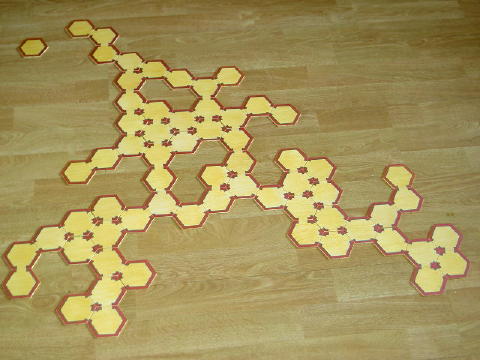Page 41 of 47
China Tangle |
|
The China Labyrinth is over forty years old and all that time one of the loose ends in my mind has been to make a game that uses solutions of the puzzle as a board. The dominating idea was to use it as a 'castle' with yet to determine pieces moving along its corridors in search of treasure or safety. Basically a movement game, and the lay-out in the picture still testifies to that. It may and probably will not matter within this idea whether the solution is transcendental or 'compact'. Because there is a dungeon, an inherently inaccessible room in the castle in either case, 'warp crystals' were envisioned, that allow you to move instantly to a predetermined room, regardless of where it may be situated. Under circumstances this predetermined room may be the dungeon. The idea never went anywhere. Then in May 2022 Nick Bentley invented Strands, a game played on a board with cells that have numbers 1 to 6 and a protocol that allows you on your turn to place as many stones on like-numbered cells as the number indicated on the first cell where a stone is placed. Different distributions of cells are possible. In the inventor's words: The board's center is the most powerful place to put pieces, but you can place more pieces per turn near the edge. You must navigate this tradeoff to win. An AI was used to determine how many pieces you can place on each region of the board, so all regions are balanced. At least according to the algorithm. The goal was to create the largest group with the count cascading down in case of equality. This rang a bell in the old brainbox. Random setups with values 1 to 6 emphatically suggested the use of the China Labyrinth as a board. The solution to my 40 years old loose end suddenly emerged like a ship out of the fog. The Labyrinth literally seemed tailored to the goal and it even harboured a refinement because it features either number-based or pattern-based follow-up placements. I felt elated! It seemed wise to only use the coherent 63-part of two-groups solutions because that way like coloured groups are in principle always connectable. The number of separate groups of cells of a solution will always equal the number of loops it has, so two-groups solutions always have two loops. There are zillions of them and each one poses different challenges. Since the solutions tend to have low numbered cells wide apart and high numbered cells closer together, the placement options have been inverted: you may not place the number of stones equal to the number of exits of the first cell, but instead you may place "seven minus the number of the first cell". Have fun :) Enschede, July 2022 christian freeling |
